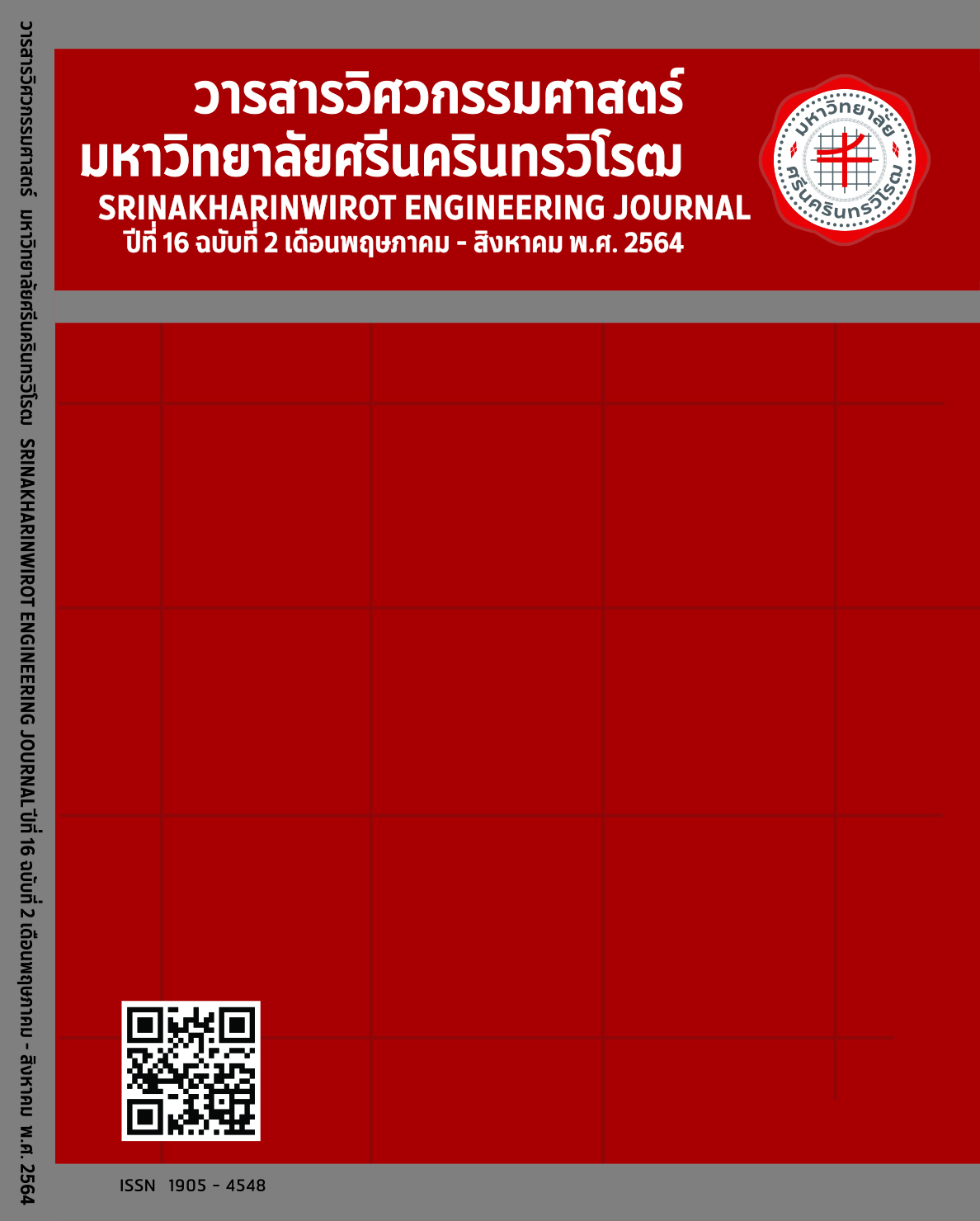กำลังรับแรงดัดของแผ่นซีเมนต์เส้นใยที่ใช้เศษแผ่นยิปซัมนำกลับมาใช้ใหม่แทนที่มวลรวมละเอียดบางส่วน
Main Article Content
บทคัดย่อ
งานวิจัยนี้นำเสนอผลกระทบของการนำเศษแผ่นยิปซัมนำกลับมาใช้ใหม่แทนที่มวลรวมละเอียดบางส่วนในมอร์ตาร์เพื่อผลิตเป็นแผ่นซีเมนต์เส้นใยตามมาตรฐาน มอก. 1427-2540 กระเบื้องซีเมนต์เส้นใยแผ่นเรียบ ผลการวิจัยระบุว่าสามารถแทนที่มวลรวมละเอียดด้วยเศษแผ่นยิปซัมได้ถึง 0.20 ต่อปริมาตรมอร์ตาร์ซึ่งทำให้มอร์ตาร์มีค่าโมดูลัสแตกร้าวเท่ากับ 4.03, 4.41 และ 4.42 เมกะปาสคาล เมื่อใช้อัตราส่วนน้ำต่อปูนซีเมนต์ (W/C) เท่ากับ 0.40, 0.45 และ 0.50 โดยน้ำหนัก ตามลำดับ ซึ่งผ่านเกณฑ์มาตรฐานกระเบื้องซีเมนต์เส้นใยแผ่นเรียบชนิดที่ 1 ที่มีค่าโมดูลัสแตกร้าวไม่น้อยกว่า 4 เมกะปาสคาล อย่างไรก็ดีมอร์ตาร์ที่มีส่วนผสมของเศษแผ่นยิปซัมนำกลับมาใช้ใหม่ไม่สามารถป้องกันการซึมผ่านน้ำได้ ทำให้จัดอยู่ในกระเบื้องซีเมนต์เส้นใยประเภท A และ B คือสามารถใช้ได้ภายในหรือภายนอกโดยไม่ถูกแสงแดดและ/หรือน้ำโดยตรงเท่านั้น
Article Details

This work is licensed under a Creative Commons Attribution-NonCommercial-NoDerivatives 4.0 International License.
ลิขสิทธิ์เป็นของวารสารวิศวกรรมศาสตร์ มหาวิทยาลัยศรีนครินทรวิโรฒ
References
TIS Standard for Gypsum Plasterboard, TIS Standard 219-2552, 2009.
A. Kongsitthanakorn, P. Sangkakit and W. Dampanrat, “A Study on Possibility of Using Synthesis Gypsum for Paving Blocks,” Bachelor’s dissertation, College of Industrial Technology, KMUTNB, 2003.
J. Sriwichai, S. Chareonsukkho, A. Chaiyasith, S. Kongsomsaksiri and N. Yamoth, “Effects of Synthesis Gypsum in Concrete,” Bachelor’s dissertation, College of Industrial Technology, KMUTNB, 2005.
T. Cholatarn, T. Klubprasith, W. Permrith, S. Kongsomsaksiri and N. Yamoth, “Effects of Water Content on Paving Concrete Blocks Made with Synthesis Gypsum,” Bachelor’s dissertation, College of Industrial Technology, KMUTNB, 2004.
N. Noochaya, W. Wisutchanon, S. Piyo, S. Kongsomsaksiri and N. Yamoth, “A Development of Paving Concrete Blocks Made with Synthesis Gypsum,” Bachelor’s dissertation, College of Industrial Technology, KMUTNB, 2004.
TIS Standard for Facing Bricks, TIS Standard 168-2545, 2003.
TIS Standard for Fiber-Cement Sheets, TIS Standard 1427-2540, 1997.
A. Attachaiyawuth, C. Ngamthanachot and C. Vivatvanavong, “Effects of Compressive Strength of Mortar using Recycled Gypsum as Partial Replacement Material,” KMUTT Research and Development, vol. 3, pp. 247-262, Jul. 2019.
WRAP (Waste & Resources Action Programme) (2009, August 5). Recycled Gypsum in Concrete Construction Product Applications [Online] Available: http:www.warp.org.uk/construction
A. Erbs, A. Nagalli, K. Q. de Carvalho, V. Mymrin, F. Hermes Passig and W. Mazer, “Properties of recycled gypsum from gypsum plasterboards and commercial gypsum throughout recycling cycles,” Journal of Cleaner Production, vol. 183, pp. 1314-1322, 2018.
D.A. Kontogeorgos and M.A. Founti, “A generalized methodology for the definition of reactive porous materials physical properties: Prediction of gypsum board properties,” Construction and Building Materials, vol. 48, pp. 804-813, 2013.
J. Zhang, X. Guan, X. Song, H. Hou, Z. Yang and J. Zhu, “Preparation and properties of gypsum based energy storage materials with capric acid–palmitic acid/expanded perlite composite PCM,” Energy and Buildings, vol. 92, pp. 155-160, 2015.
S. Sair, B. Mandili, M. Taqi and A. El Bouari “Development of a new eco-friendly composite material based on gypsum reinforced with a mixture of cork fibre and cardboard waste for building thermal insulation,” Composites Communications, vol. 16, pp. 20-24, 2019.
T. Raghavendra and B.C. Udayashankar, “Engineering properties of controlled low strength materials using flyash and waste gypsum wall boards,” Construction and Building Materials, vol. 101, pp. 548-557, 2015.
H. Liang and J. Li, “The influence of hydration and swelling properties of gypsum on the preparation of lightweight brick using water supply reservoir sediment,” Construction and Building Materials, vol. 94, pp. 691-700, 2015.
M. Garg, A.K. Minocha and N. Jain, “Environment hazard mitigation of waste gypsum and chalk: Use in construction materials,” Construction and Building Materials, vol. 25, pp. 944-949, 2011.
Q. L. Yu and H. J. H. Brouwers, “Development of a self-compacting gypsum-based lightweight composite,” Cement and Concrete Composites, vol. 34, pp. 1033-1043, 2012.
P. Sormunen and T. K?rki, “Recycled construction and demolition waste as a possible source of materials for composite manufacturing,” Journal of Building Engineering, vol. 24, 100472, pp. 1-14, 2019.

